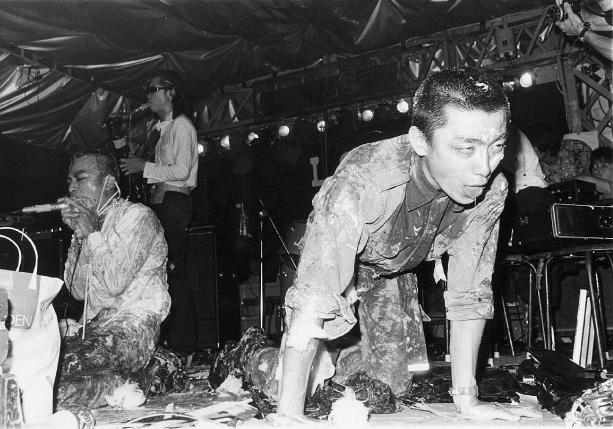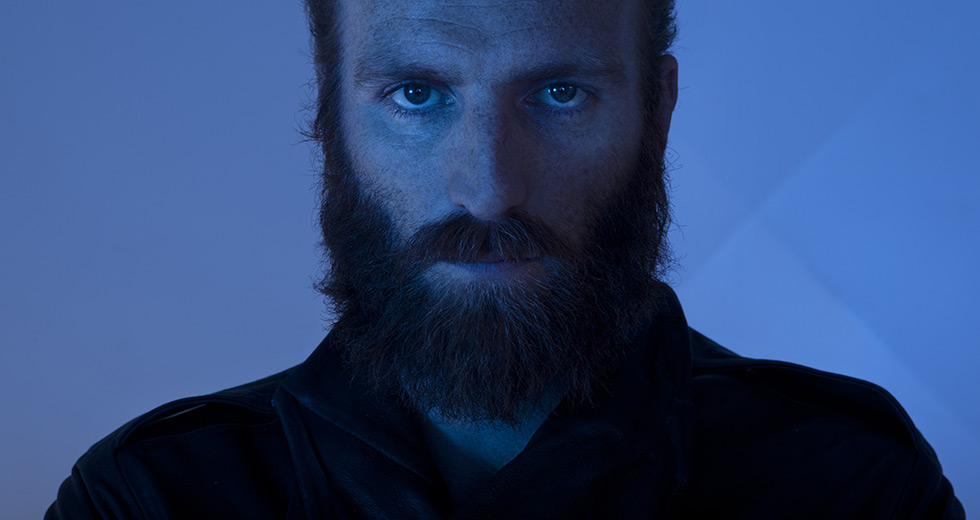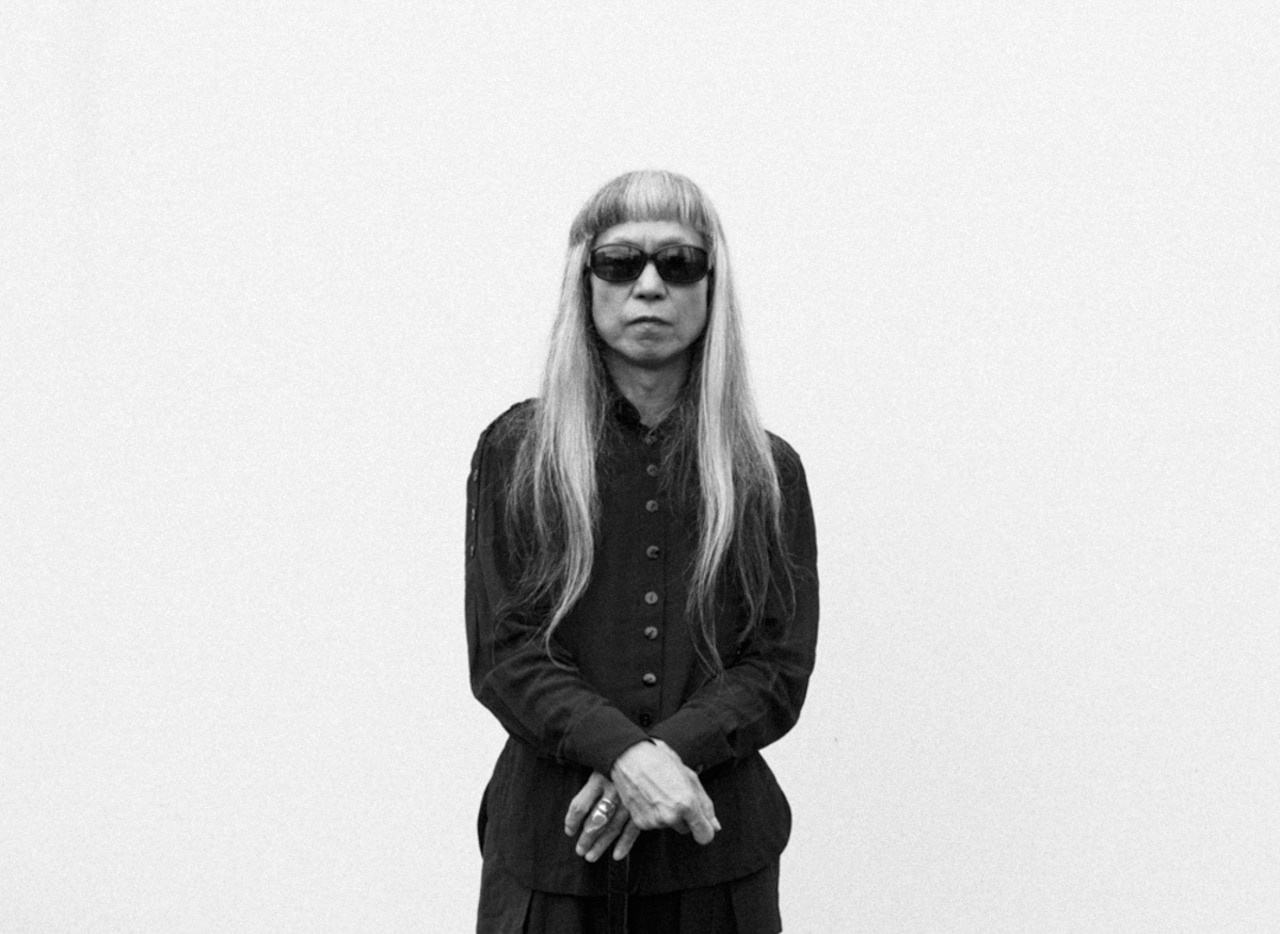
A Guide to Keiji Haino
One of Japan’s most challenging and vital artists, in 15 records.
“First and foremost, I am a singer,” says Keiji Haino, one of the most intriguing and mysterious figures to emerge from the Japanese psychedelic underground. For over four decades now, Haino has been pursuing an intensely personal vision of what psychedelic music can be, drawing influence from music as disparate as Billie Holiday, The Doors, Blue Cheer, Munir Bashir, Hossein Alizâdeh, and countless others whose mission is the same as Haino’s own: to push the music further on and further out into the infinite.
Haino himself sometimes feels like a mess of contradictions. A purveyor of some of the most psychedelically obliterated music in the world, he’s a strict teetotaller. One of the loudest performers in rock music, his songs excel when they’re performed in quiet, intimate spaces.
A rebellious force since his early years, when he would relentlessly question authority throughout his strict schooling, Haino was initially drawn to drama, and considered becoming an underground actor. His first encounter with Jim Morrison changed the course of his life, and he decided that rock music was the way to go. His first group, Lost Aaraaff, named after a poem by Edgar Allen Poe, were part of the Japanese underground in the early ’70s; at one of their first performances — at 1971’s GENYA Festival alongside Brain Police, Blues Creation, and Masayuki Takayanagi’s New Direction For The Arts — they were met with rocks hurled from the surrounding fields. Haino would go into retreat for several years in the ’70s, focusing in on exploring the extremities of his own music. He re-emerged toward the end of the decade with his rock group Fushitsusha, and became a part of the scene building around the legendary venue Minor.
Haino’s aesthetic is voraciously globe-swallowing, yet simultaneously rooted in his homeland. He often extrapolates outwards from some of the wilder moments in Japanese rock music: the sudden screams of feedback which bisect the cover of “Hey Joe” by Group Sounds gang The Golden Cups; the hermetic eschatology of The Jacks; the hard-won enigma that is Les Rallizes Denudes. He also offers his interpretation of ma, the Japanese concept which Alan Cummings describes as “the haunted spaces between the notes”; Haino finds these balancing moments of empty, blank space, in sources as seemingly disparate as blues player Blind Lemon Jefferson and psychedelic outcast Syd Barrett.
With a body of work that stretches to well over 100 albums, here are the 15 albums that, taken together, paint one picture of Haino, as an artist. I’ve tended to avoid his many collaborative releases in favor of expressions from Haino’s very self.
Keiji Haino - Watashi Dake? (Pinakotheca, 1981; reissued PSF, 1993)
Watashi Dake? (Only Me?) is a set of gnomic, crepuscular songs, cellular in their structure. It marks Haino’s first volley into the late-night netherworld; this music is both as dark and as beautiful as the deep black of its cover art. It’s an album of two parts: quieter, reflective melancholy, and righteous guitar noise. When he’s on a downer, Haino’s guitar tone is all muted Venusian blues, the treble stolen from the air while he clanks and scratches at the strings as if he’s on the chain gang.
However, when Haino tears into amplification, his guitar stings; its predominant tone is a dive-bombing raid on the ears. Meanwhile, his vocals leap between consumptive moans and screams torn direct from Artaud’s radio broadcasts. PSF’s reissue adds an ecstatic 28-minute solo guitar excoriation, where Haino begins to tease out what he can do in these marathon performances.
Fushitsusha - (Double Live) (PSF, 1989)
The appearance of the first Double Live in 1989 was a heavy revelation for anyone in the know. While they would later settle into a trio, here Fushitsusha is a quartet, with second guitarist Maki Miura shadowing Haino’s moves, freeing him to blast some alien, Dylan-circa-’66 harmonica. Indeed, at this point, Fushitsusha are taking on the freedoms implicit in those world-wrecking Dylan & The Hawks shows, dizzyingly flexible in their attack yet always grounded by the ne plus ultra of rock movement. Fushitsusha would go on stake out wilder territory on later albums, but this is a great reminder of just how potent a rock performer Haino can be, and how brightly he shines when backed by sympathetic musicians.
Kan Mikami, Keiji Haino & Motoharu Yoshizawa - Live in the First Year Of Heisei Volumes One & Two (PSF, 1990)
After the release of Watashi Dake?, Haino suffered a three-year-long illness. His return to music in the mid-’80s coincided with an increased interest in the psychedelic Tokyo underground, and Haino fell in with groups like psych-motor rockers High Rise, whose singer and bass player Asahito Nanjo was responsible for introducing Haino to Hideo Ikeezumi, of the Modern Music shop and the PSF label. Most of Haino’s signature early sides would appear on PSF, such as the two Fushitsusha Double Live sets, and Live in the First Year of Heisei, a collaboration with actor and folk-blues legend Kan Mikami and free improvising bass player Motoharu Yoshizawa.
The title is slightly deceptive: parts of this two-volume release were recorded in 1987, the 62nd year of Showa. Pedantry aside, Live in the First Year of Heisei has Haino at an early collaborative peak. Mikami’s songs are tough, dry-skinned beasts and his voice, a guttural yowl, is the perfect foil for Haino’s fiery, reverb-drenched guitar playing. But there’s great sensitivity here too, particularly in Yoshizawa’s fluid arco bass, which nestles gracefully between Haino’s six-string fury and Mikami’s blunt, flick-knife strum.
Haino’s also back on the harmonica for some of the second volume, continuing his explorations of Dylan’s mightiest era – this time, he comes on as though he’s playing just before the flood, channelling what writer David Keenan recently referred to as Dylan’s “extreme form of bodily gnosis” on the harmonica, “where it almost feels like he is tasting the sounds.” Haino and Mikami would later form a folk-blues power trio called Vajra with drummer Toshiaki Ishizuka, but Heisei is where it all starts.
Keiji Haino - Nijiumu (PSF, 1990)
Nijiumu is one of the darkest passes in Haino’s discography. Like many of his recordings of this era, the music of Nijiumu is placed at a slight remove from the listener – it’s as though you’re hearing the performance from the other side of the long blank, cloaked in deep blue reverb. The abstruse songs on Nijiumu are also among the closest Haino has come to medieval music, which has been a love of his since the early ’70s, when he first heard the droning of Thomas Binkley’s rebec.
On Nijiumu, Haino internalises the monophonics of medieval music. The album opens with a short study for fragile guitar and voice before distant metallic friction descends, scraping away at the studio reverb while Haino sighs from behind the curtain. The real core of Nijiumu, however, is the lengthy drone for strange strings which dominates the middle of the album. Haino’s voice rings out in consort with the drone, chanting an uncertain hymnal with all the power of Popol Vuh founder Florian Fricke’s devotionals: “Sing, for song drives away the wolves.”
Fushitsusha - (Double Live II) (PSF, 1991)
(Double Live II) gracefully dismantles rock’s archetypes with simple rhythmic conceits, traditional instrumental hierarchies and orderly, predictable rock dynamics. Haino is joined by the late Yasushi Ozawa on bass and Jun Kosugi on drums; the latter’s thunderous punctuations send each song’s rhythms spiraling. Haino’s guitar is incendiary, splitting off into vectors of no-mind, pre-syntactical gush: at almost every turn, his playing illuminates the fundamental lie of music-as-narrative, instead existing purely in the unpredictable now.
(Double Live II) was one of the first Haino records to receive serious attention in the West: American fanzine Forced Exposure ran a glowing review in their final issue. But it wasn’t without peers. (Double Live II) appeared congruent to a number of other underground operatives also releasing career-defining, genre-gobbling doubles, such as Royal Trux’s Twin Infinitives, Richard Youngs & Simon Wickham-Smith’s LAKE, and The Dead C.’s Harsh ’70s Reality. They’re all great, but (Double Live II) burns brightest.
Keiji Haino - Itsukushimi (PSF, 1992)
Recorded live on December 30, 1991 at Gospel, Tokyo, Itsukushimi (Affection) is a heartbreaker. It’s a deceptively fragile performance, programmed as one long piece, though clearly made up of constituent songs. For the first 20 minutes, the guitar barely raises itself over the parapet, as Haino uses it to sketch simple folk songs that pivot on deceptively simple chord changes.
When he does raise the volume, it’s mostly brief – plotting out a mechanical riff or shifting the performance to another level of intensity with a minute-long blast before another pearl-like song descends from the skies. This more pensive side of Haino sometimes alienates the rev-heads solely in search of hyper-amped rock kicks, but albums like Itsukushimi allow Haino to really embrace his first love: his voice.
Nijiumu - Era of Sad Wings (PSF, 1993)
As the group’s name suggests, Era of Sad Wings deepens the explorations of Haino’s 1990 Nijiumu album. This time, though, he’s hooked up with other players – Asahito Nanjo of High Rise among them – and relocated the sessions to rooms rich with cavernous reverb, where the playing is wiped of its individual characteristics, everything submitting to the greater will of the collective as they search for the essence of their “global ancient music.”
These ten pieces float through the air like clouds of deep blue fug, with extended passages for wilting strings underscored by heavy blocks of deadweight bass rumble. Sometimes Haino soars in from the wings, sighing to himself in his most dejected falsetto. A heavy, disorienting listen, it’s no surprise to discover modern psych artists like Ben Chasny and Steven R. Smith are big fans.
Keiji Haino - Tenshi No Gijinka (Tzadik, 1995)
Tenshi No Gijinka (Imitator Of Angels) begins with a loud strike of percussion, ringing out like the “sonorous explosions” of ancient Greek music. For much of the following 55 minutes, Haino devotes himself both to his tonsils and to his collection of hand-held percussion. The nakedness of much of this music, combined with the processional movement of some of the drums, gives Tenshi No Gijinka a particularly abstracted, ritualistic tenor: with Haino’s best albums, you’re relocated to another zone of experience.
Released on John Zorn’s Tzadik label, Tenshi No Gijinka was one of the outcomes from Zorn’s and Haino’s friendship across the ’90s (the pair were introduced by Ikeezumi and Mikami). Zorn eventually released a clutch of Haino-related albums. This one’s the best.
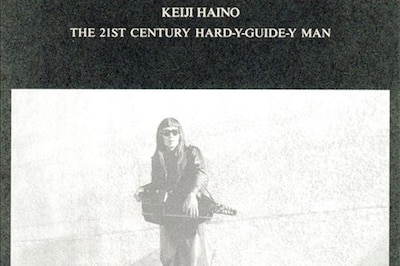
Keiji Haino - The 21st Century Hard-Y-Guide-Y Man (PSF, 1995)
Even great musicians aren’t averse to the odd bad pun, and so it is with The 21st Century Hard-Y-Guide-Y Man, the first of Haino’s albums devoted to hurdy gurdy, an ancient French instrument which, over the centuries, has landed in various hands. (Usually considered a beggar’s tool, it was also a courtly diversion during the 17th century.) But Haino’s interest is as much in the mechanics of the instrument as its raspy, droning sound – he was drawn to the hurdy gurdy as he thought it was the only instrument where the player is required to turn a handle. (Critic Clive Bell once archly sniffed in response, “Clearly Haino hasn’t yet discovered the barrel organ.”)
What he does with the instrument is at once archaic and modernist – leaning heavily on the hurdy gurdy’s ability to create complex, bustling drones, he pushes the instrument to its limits, every crank of the resined wheel unleashing strange architectures of tone. For the monolithic closer, Haino pumps the hurdy gurdy through a wall of amps and effects pedals, strings made elemental by electricity.
Keiji Haino - The Book of “Eternity Set Aflame” (Forced Exposure, 1996)
In the mid-’90s, Haino was releasing albums at a prolific rate, as if to make up for lost time across the ’70s and ’80s. With such an influx of releases, it’s inevitable that there would be better and lesser recordings. But very few Haino records have felt as all-encompassing as this one. “Eternity Set Aflame I” still stands as Haino’s most exciting and eviscerating solo guitar performance on record, a swarm of overloaded, distressed signal, which wreaks havoc with your ability to process the sheer density of information pouring through your speakers. The guitar was meant to sound like this; it just took a while to get there.
A more penumbral piece for electronics follows, in the vein of the spectral Ama No Gawa (recorded 1973, released 20 years later), before Haino returns to the guitar for a lengthier excursion into the black infinite. The Book Of “Eternity Set Aflame” is consummate Haino.
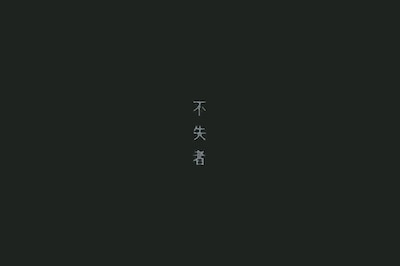
Fushitsusha - Origin’s Hesitation (PSF, 2001)
With drummer Ikuro Takahashi leaving the drummer’s seat, Haino was faced with a dilemma: how to replace the best drummer in the group’s history? With a typical combination of pragmatism and hubris, he finds the answer: take over the drums himself.
The result is one of Haino’s most unyielding, perplexing albums. While it starts with Haino seemingly thrashing the trap set to within an inch of its life, plenty of Origin’s Hesitation falters and stutters, exploring the resonance of each drum or dropping snare hits with sudden cut-offs, alienating the instrument from our expectations. Haino’s voice is particularly gut-wrenching here, sometimes looping his raw cries into crescendos of despair and rage, while Ozawa replies with bass that’s more hesitant than usual – on “Two Exist,” he peels single, bell-like tones high up the neck and carefully places them floor of the on the studio. As a lesson in triumph over adversity, Origin’s Hesitation has Haino coming out, all punches and body blows.
Keiji Haino - Mazu wa iro o nakusouka!! (PSF, 2002)
Much discussion of Haino rests on his embrace of high volume theatrics as his ultimate expression, as though you can get a sense of who he really is through reducing Haino to bland caricature. Albums like Mazu wa iro o nakusouka!! (First, Let’s Remove the Colour!!) conversely suggest that Haino’s real genius may lie in the smoky, intimate blues rituals he peels from his larynx and guitar when seated alone in darkness.
Mazu picks up the thread left by Haino on Itsukushimi and Nijiumu, but his use of loops to build a hall of mirrors and the whispered closeness of his voice takes this set of songs to another level. File next to Skip Spence’s Oar, Jandek’s electric blues, or those sainted Loren Connors and Suzanne Langille albums for when you’re lost deep in the nest of evening.
Keiji Haino - ‘C’est parfait’ endoctriné tu tombes la tête la première (Turtle’s Dream, 2003)
An astonishing document of a particularly charged 2002 live performance for voice and rhythm machine, ‘C’est parfait’... is all the evidence you need that Haino’s true weapon is his deeply compassionate voice. While on first listen, you might be hypnotised by the complex skeins of rhythm and chant he builds from seemingly simple loops. A closer listen reveals the intimacies of the spaces between, the glorious pause before Haino brings his voice back to the air, building and building in exhilarating multiplicity; the devastatingly personal poise of the stretches of solo singing; the closing wipeout, where both voice and rhythm machine dissolve into primordial noise. This is about as close to the very essence of Haino as you’re likely to get. Approach with caution and respect.
Fushitsusha - Hikari To Nazukeyou / Mabushii Itazura Na Inori (Heartfast, 2012 / 2013)
After Origin’s Hesitation, there were no more new Fushitsusha albums, only archival sets, and with the passing of long-term bass player Ozawa in 2008, it looked like the group was retired for good. But their presence obviously weighed heavy on Haino’s mind: in 2010, his trio Seijaku released an album called Mail from Fushitsusha. Regardless, the sudden appearance of these two Fushitsusha albums, released within a month of each other, were no small cause for celebration.
Given Haino’s relentlessly questing nature, it’s no surprise to discover a newly refueled trio playing some of the most compelling rock of Haino’s career: sometimes devastatingly oblique, and sometimes snarling and direct. Hikari To Nazukeyou is a lesson in brevity: at only 36 minutes, it’s a short, sharp shock from a group usually more inclined toward the long sprawl, with Haino pushing jagged, elliptical riffs out of his guitar while the rhythm section endlessly circle each other.
Mabushii Itazura Na Inori sometimes covers similar terrain, as on the spiraling patterns of “Togisumasareru no wa...,” which cleave the very song apart at its seams. There’s far more space in this album – it’s surprisingly spare in its structure. Yet again, Haino has found a way to re-read that traditional concept of ma: the silences here are heavy with density. And when he plucks the most beautiful chords from the firmament, on the closing “Bokuninatteiru,” well, it’s yet another realisation that, for Haino, permanence is all. The bad faith artists that clog up the airwaves, leaping upon scenes and movements like so many tomorrows, are not for him. Haino is Haino is Haino.
